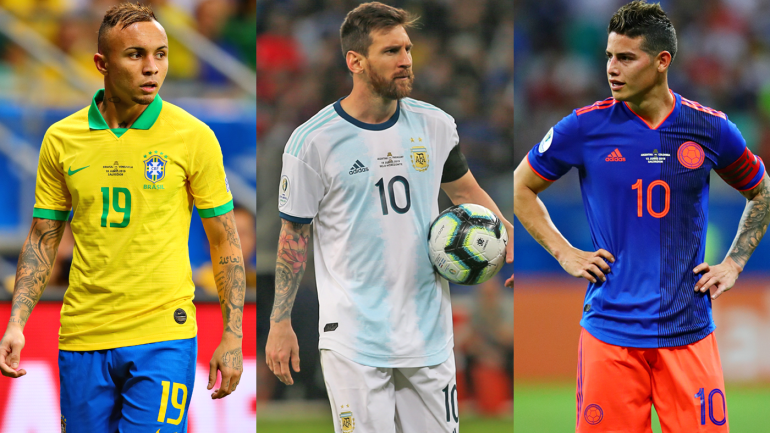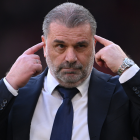
There's a sentence in Eduardo Galeano's beautiful book, "Soccer in Sun and Shadow," where the Uruguayan writer states, "All Uruguayans are born shouting 'Goal!' and that's why there's always such a tremendous racket in our maternity wards."
The line, as humorous as it is, is also a metaphor for how South Americans feel about their fútbol. And perhaps, most importantly, it's a reminder of what's at stake for CONMEBOL nations whenever World Cup qualifiers come around. But now, in the midst of a global pandemic, one that has been extra cruel on Latin America, the obstacles for these 10 nations are that much steeper to climb.
FIFA's and CONMEBOL's indecisions made it confusing for a while if South American players were even allowed to travel to the continent in the first place and if these matches would even happen. Most of the talent play abroad and due to different governmental protocols from different nations in regards to quarantine, respective clubs have been hesitant to release certain members and send them to a seriously affected area in the world. MLS clubs D.C. United and NYCFC, for example, did not release three Peruvian players (Yordy Reyna, Alexander Callens and Edison Flores) and as the league doesn't follow a FIFA international window, clubs prioritized not just the health aspect but also the logistical one as players who do travel to South America would have to quarantine once they return, making them unavailable for several matches. But it's not just MLS. Venezuela is also missing key people such as Salomon Rondon, who plays in the Chinese Super League, and is not allowed to leave.
Alas, in the end, the show must go on and CONMEBOL World Cup qualifiers -- arguably the most exciting, toughest out of any group in the globe --- start this week. Regardless of empty crowds in this window, the challenges are still there for every team as geography plays a major factor in these matches. From La Paz (12,000 feet above sea level) or Quito (9,000 feet above sea level) or dealing with the heat from Barinas in Venezuela or Barranquilla in Colombia, mother nature is a heavy presence for these teams. But what makes CONMEBOL qualifiers also so exciting is the diversity in coaching and talent. From Uruguay's no-nonsense Garra Charrúa (the collective to die for every tackle, every challenge, every goal) to Brazil's aesthetically pleasing style, there's something for everyone.
But the truth is that these teams have not played since November of 2019 so rust is almost surely a reality.
Here's a quick look on every South American team and what's in store for each team:
Brazil (FIFA rank: 3)
- Friday, Oct. 9: vs. Bolivia (8:30 p.m. ET, pay-per-view)
- Tuesday, Oct. 13: at Peru (8 p.m. ET, pay-per-view)
It's hard to bet against the Copa America champions who only lost one game in the 2018 World Cup qualifiers (the first game against Chile) and whose squad looks more dangerous than ever. Never mind well known talents such as Neymar Jr., Richarlison (who seems to be fine despite an apparent injury against Brighton last weekend), Gabriel Jesus or Phillipe Coutinho. Coach Tite now has youth to compliment experience. Watch out for Everton Cebolinha, who was a star at last summer's aforementioned Copa America and recently joined Benfica. At the back, they're also shaping up nicely as Atletico Madrid's Renan Lodi and new Man United defender Alex Telles provide so much depth. Speaking of depth, when it comes to goalkeepers, Brazil has an embarrassment of riches, which is why it's OK for Brazilian fans to relax when they don't see Alisson in this window due to injury. Man City's Ederson or Weverton from Palmeiras are right there to prove that they should be the Selecao's No. 1. In the end, there may be some challenges along the way, but I don't see anyone topping the five-time World Cup champion from the top spot.
Uruguay (FIFA rank: 6)
- Thursday, Oct. 8: vs. Chile (6:45 p.m. ET, pay-per-view)
- Tuesday, Oct. 13: at Ecuador (5 p.m. ET, pay-per-view)
Uruguay is like the sun in the morning. You always know they're going to show up. Thanks to legendary manager Oscar Tabarez and a tradition in Uruguayan football that encourages hard work and nothing else, this team is never a walk in the park. There is no Edinson Cavani and it's not a surprise. The team's assistant coach Mario Rebollo discussed concerns regarding his fitness as he had not seen action for many months, but now with Man United, this will change and perhaps a call will come in November. For now, however, he is out, leaving the duties to Luis Suarez as the team's star No. 9. But Uruguay, like every other team, will also take advantage of youth as six uncapped players enter the squad, including the always-impressive Nicolas de la Cruz (River Plate) and LAFC star and current MLS top scorer Diego Rossi. Uruguay can most definitely top this qualifying group. The key for them is consistency away from home.
Argentina (FIFA rank: 9)
- Thursday, Oct. 8: vs. Ecuador (8:10 p.m. ET, pay-per-view)
- Tuesday, Oct. 13: at Bolivia (4 p.m. ET, pay-per-view)
Lionel Scaloni's team bowed out from last summer's Copa America at the hands of its foe and eventual champion Brazil in the semifinals but La Albiceleste did earn third place and we've seen some good moments under the 42-year-old manager. More importantly, Lionel Messi believes in Scaloni's vision and despite the fact that the Barcelona star is aging, his talents are obviously still needed. Offensively, even without Sergio Aguero, they are still a force. Messi aside, players like Sevilla's Lucas Ocampos and Inter's Lautaro Martinez are going to be a nightmare for any opposing defender. The problem, as always, will be Argentina's defensive and midfield duties when they don't have the ball. But there are players who are improving thanks to their club performances. Leandro Paredes, for example, is really coming into his own for PSG and should be a major factor in this window. At the back, Emiliano Martinez from Aston Villa should get the nod in goal ahead of the popular Franco Armani, while center back Lucas Martinez Quarta, a recent arrival to Fiorentina from River Plate, should impress.
Colombia (FIFA rank: 10)
- Friday, Oct. 9: vs. Venezuela (7:30 p.m. ET, pay-per-view)
- Tuesday, Oct. 13: at Chile (8:30 p.m. ET, pay-per-view)
Manager Carlos Queiroz's biggest headache is in goal as David Ospina was not allowed to travel due to COVID-19 infections within his club Napoli. Enter uncapped America de Cali stopper Eder Chaux to join Camilo Vargas, Alvaro Montero and Aldair Quintana to challenge for the No. 1 spot. Elsewhere, the offensive talent remains strong as James Rodriguez, Radamel Falcao and Juan Cuadrado join Atalanta's duo Luis Muriel and Duvan Zapata. Goals, therefore, are almost a guarantee with Colombia. Someone missing is the impressive Juan Fernando Quintero as his pending move to China from River Plate has been put on hold due to visa issues, so lack of playing time has been a factor. Regardless, Los Cafeteros are as dangerous as ever, the only question is if they can be organized enough defensively? Time will tell.
Chile (FIFA rank: 17)
- Thursday, Oct. 8: at Uruguay (6:45 p.m. ET, pay-per-view)
- Tuesday, Oct. 13: vs. Colombia (8:30 p.m. ET, pay-per-view)
Chile, who is going through a major generational change, has had to adapt tremendously as it looks ahead to two tough matches in Uruguay and Colombia. For one, there are the injuries. Claudio Bravo, Erick Pulgar, Pablo Aranguiz, Guillermo Maripan, Gary Medel and Fabian Orellana are all out due to injury forcing manager Reinaldo Rueda to make changes. But La Roja can surprise people, as we saw last summer in Copa America, where few saw them getting out of the group stage and made it all the way to the semifinals before losing to Peru. The likes of Alexis Sanchez, Eduardo Vargas and Arturo Vidal are still there, but the question is, as the golden generation says goodbye, can they help the younger, less experienced members of the team reach a World Cup spot?
Peru (FIFA rank: 22)
- Thursday, Oct. 8: at Paraguay (7:30 p.m. ET, pay-per-view)
- Tuesday, Oct. 13: vs. Brazil (8 p.m. ET, pay-per-view)
The biggest question for last summer's Copa America finalist is what to do without their injured captain and all-time goalscorer Paolo Guerrero, who is out for the year due to a knee injury. Guerrero is an instrumental voice and his absence will be missed, but this squad knows each other and Ricardo Gareca's system so well that there are multiple ways La Blanquirroja can hurt an opponent. Jefferson Farfan, healthy again after going through injury and coronavirus, could act as a No. 9 and there is also the red-hot Raul Ruidiaz from Seattle Sounders. Though, his presence with the national team has never quite lived up to expectation on a consistent basis. Let's hope that changes for Peru's sake. Aside from new additions, the added bonus is that more Peruvians are playing in international leagues now more than ever. There's the terribly underrated Renato Tapia (Celta Vigo), Luis Advincula (Rayo Vallecano), Miguel Araujo and Sergio Peña (FC Emmen) as well as Christian Cueva finding a home in Turkey with Yeni Malatyaspor. Add the heavy influx in MLS and the Peruvian landscape is looking brighter. Their biggest enemy, however, is themselves, so getting results against lesser opposition is a must if they are to repeat the successes of last time around when they qualified for Russia after earning the last spot and beating New Zealand in the playoff game.
Venezuela (FIFA rank: 25)
- Friday, Oct. 9: at Colombia (7:30 p.m. ET, pay-per-view)
- Tuesday, Oct. 13: vs. Paraguay (6 p.m. ET, beIN Sports)
After the departure of manager Rafael Dudamel, who left in January after nearly four years in charge of La Vinotinto, Venezuela now looks for another campaign and finally do something it has never done before, reach the World Cup. Enter Portuguese manager Jose Peseiro, who has an impressive resume, which includes managing Saudi Arabia, Porto, Braga, Sporting CP and even an assistant at Real Madrid. The latter is where he worked under Carlos Queiroz, who he'll face when his team plays Colombia this Friday. The biggest criticism of Peseiro's game is that his teams are often without a proper style, almost incognito in a game. Add to the fact that Venezuela will miss key players such as the aforementioned Salomon Rondon and Jose Martinez from Philadelphia Union and these matchups could prove difficult.
Paraguay (FIFA rank: 40)
- Thursday, Oct. 8: vs. Peru (7:30 p.m. ET, pay-per-view)
- Tuesday, Oct. 13: at Venezuela (6 p.m. ET, beIN Sports)
Quite frankly, it's hard to pinpoint Paraguay's system and trajectory because it's somewhat inconsistent. While Eduardo Berizzo led the team to the Copa America quarterfinals and were only eliminated on penalties after a goalless draw with Brazil, they reached it without winning a game. So it's hard to understand their strengths and weaknesses, especially after such a long time without playing. But there is talent that extends beyond Miguel Almiron, including Andres Cuba from Ligue 1's Nimes Olympique and Real Betis striker Antonio Sanabria. Paraguay's chances remain up in the air, but if there is belief with this squad, then anything is possible.
Ecuador (FIFA rank: 64)
- Thursday, Oct. 8: at Argentina (8:10 p.m. ET, pay-per-view)
- Tuesday, Oct. 13: vs. Uruguay (5 p.m. ET, pay-per-view)
This team has always been a mystery. They have talent from all over the country, with tremendous ability and focus. In fact, during the Russia qualifiers, they were leading the group after winning their first three games but by the end, the plan had gone topsy-turvy. The other issue was the lack of consistency off the pitch, mainly due to the pandemic and change of leadership with the nation's football federation. Jordi Cruyff was hired as manager in January but due to COVID-19, traveling back and forth to Ecuador was not permitted so the decision for him to leave occurred in the summer. As a result, Ecuador hired Gustavo Alfaro, who left Boca Juniors after one season. Alfaro's biggest criticism is there is no identity under his team, and this is something that Ecuador desperately needs as the squad is also going through a transition. But they are talented, that's for certain. Watch out for eye-catching players such as 18-year-old Moises Caicedo (Independiente del Valle) and Leonardo Campana (bought by Wolves, on loan to Portuguese club Famalicão.) Ecuador may not be anyone's favorite, but they can most definitely disrupt a party.
Bolivia (FIFA rank: 75)
- Friday, Oct. 9: at Brazil (8:30 p.m. ET, pay-per-view)
- Tuesday, Oct. 13: vs. Argentina (4 p.m. ET, pay-per-view)
Bolivia's start to these qualifiers begins with two gigantic obstacles, Brazil and Argentina, so it's fair to say that the tough challenges for this nation begin right away. After a disappointing campaign in Copa America where they lost every game, Cesar Farias took over the role of manager from Eduardo Villegas. Farias oversees the entire setup, including the U-23s, so he is aware of any hidden gems outside of the senior squad. He already caused some shocks earlier this year before the pandemic struck as he led Bolivia's U-23 squad to beat Uruguay and Peru in CONMEBOL's pre-Olympic tournament, so there are opportunities here to make a statement. Given this, it's no surprise that this squad is filled with youth but also players with experience in Europe, including Boris Cespedes, who plays for Servette in Switzerland. Jaume Cuellar is another one to watch out for. The 19-year-old forward who plays for SPAL in Italy became the first Bolivian to play in Serie A before getting relegated.
Still, Bolivia's biggest ally is their home advantage as playing in La Paz's altitude will always act as their 12th man.





















